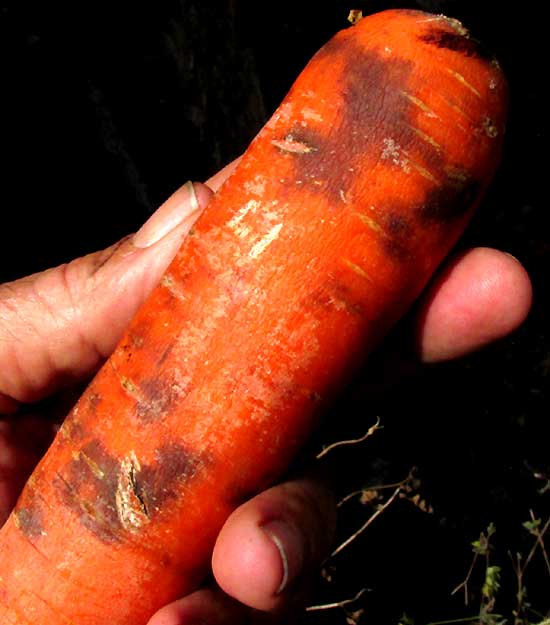Excerpts from Jim Conrad's
Naturalist Newsletter
from the March 22, 2019 Newsletter issued from Rancho Regensis north of Valladolid, Yucatán, MÉXICO;
elevation ~40m (~130 ft), N~20.876°, W~88.170°
STORED CARROTS DEVELOPING BLACK SPLOTCHES
By the time the fruterías in our backcountry area receive their fruits and vegetables for sale, normally the products have been on a long journey, for the Yucatan is too arid and the soil too abused to produce much here. Often by the time our fruits and vegetables hit the display stand, they look less than fresh. For example, nearly all the carrots I buy locally are blemished with black splotches such as those shown below:

This week it occurred to me that the splotches probably are caused by a fungus, that the fungus species would have a life history, and that it might be interesting to know more about it. Especially I wondered whether eating carrots from which the splotches haven't been completely removed might be bad for the health.
Best I can tell, the splotches are known in the carrot-selling world as Black Root Rot, described as a blackening that often is circular in outline, is superficial, and has a sooty appearance. Two fungus species may cause it: Thielaviopsis basicola and Chalaropsis thielavioides.
Both these species occur naturally in the soil. When carrots are wounded during the harvest, the fungi enter through wounds and abrasions. The black spots develop on carrots stored at room temperature and high humidity. They often develop on carrots stored in plastic bags from which moisture can't escape.
Thielaviopsis basicola is a member of the Ascomycota fungus phylum, along with molds, mildews, the edible mushroom known as the Morel, and other lesser known kinds of fungus. The species, besides infecting carrots, attacks many other kinds of plants, including petunias, snapdragons, sweet peas, verbenas and violets. In those plants the leaves and root system become stunted when contaminated, plus their leaves yellow between the veins and their branches may die back. Chalaropsis thielavioides seems to be much less studied than Thielaviopsis basicola, but probably behaves similarly.
During my information search no mention at all was found about the toxicity of carrots with black splotches. That suggests that it's not an important issue. Still, I'm going to continue cleaning my carrots. I just won't worry too much if a few black specks make it past me.